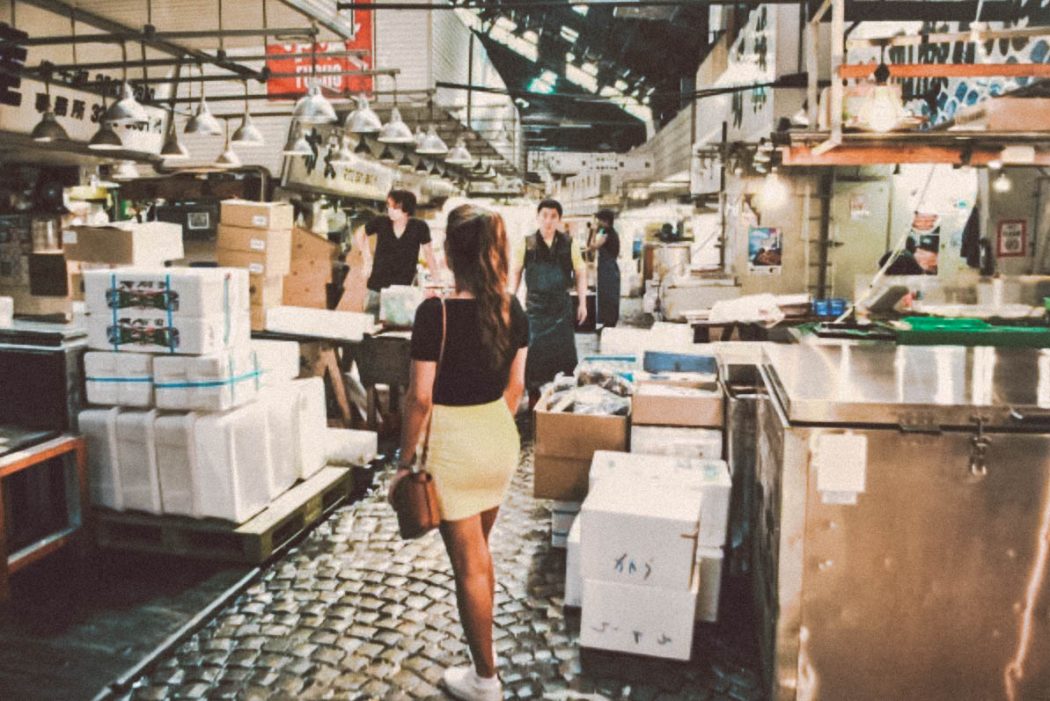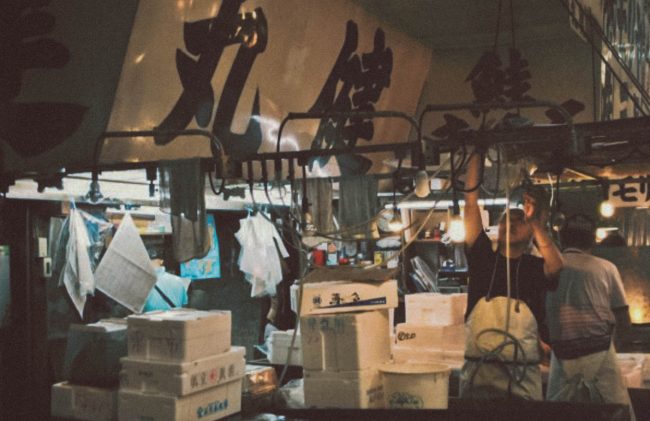Did you know the Japanese eat more fish per capita than any other developed country? In fact, 128 pounds are consumed annually, compared with a global average of 37.7 pounds.
There is no better place to find the world’s finest seafood than the bustling Tsukiji market, an impressive mixture of warehouses, restaurants and retailer shops that has been part of Tokyo’s economic fabric for more than 80 years.
Selling over 2000 tons of seafood a day, it comes as no surprise that locals call it “A Kitchen for 12 million people in Tokyo”. The market never sleeps. With Around 42.000 workers and 19.000 vehicles passing through its doors every day, Tsukiji is 32 football fields in size.
Whether you arrive early in the morning for the frantic pre-dawn tuna auctions or later in the morning for a look around and a sushi breakfast, like we did, the world’s biggest fish emporium is definitely a must-see stop for any visitor to Japan.
Unfortunately, Tokyo´s kitchen is preparing for a big move. Apparently, there are plans to relocate it from its current shabby wooden warehouses to a modern facility about 40% larger in the Toyosu district, less than two miles South along Tokyo Bay.
According to many Tsukiji veterans, the new iteration with its multi-storied glass structure will be more like a shopping mall where you can buy fish, so make sure you catch the last days of the Tokyo Fish Market.
Exploring Tsukiji Market
As we were still fighting jet-lag, we decided not to attend the ritual of tuna auctions. So, we took the subway on a sunny summer morning and got off at the closest station, the Tsukiji Shijo Station on the Toei Oedo subway line.
The Busy Outer Market (jogai shijo)
Surrounding the inner market, there is a labyrinth of food stalls, restaurants, groceries and small shops selling kitchen ware like knives, chopsticks, bowls, seaweds and baubles.
The 200-square meter area is packed with tourists, shoppers, purveyors, cars, trucks, vans, turrets, motorcycles, bicycles…There is a sense of whimsical controlled chaos everywhere.
The Inner Market
After exploring the lively fun Jogai Shijo market, we continued onto the inner market. Once inside, I felt completely intoxicated by the wonderful smell of fresh fish that wafted down the laneway.
Listed among Japan’s most popular attractions by the Japan National Tourism Organization, the iconic market could also be considered as the world’s finest theatre. The scene is difficult to describe with words, so you definitely have to step into it yourself.
Over 60.000 people come everyday to the damp, dark Tsukiji market to buy or sell fish. As you can imagine, the enormity of the place is overwhelming. Imagine every kind of fish imaginable -blue and yellowfin tuna, garfish, salmon, swordfish, snapper and about 480 other species- cascading from sparkling white styrofoam boxes while countless forklift trucks move around back and forth at an incredible high speed.
Boxes filled with ice water and fish are displayed to customers under bare incandescent bulbs. Mountains of empty polystyrene packing cases are everywhere while rock-solid tuna are laid out in neat rows waiting to be delievered in carts.
With no other tourists around, I ventured myself among stalls to watch fish mongers at work. Decked out in aprons and rubber boots, they were carefully filleting the day´s catch while a few meters away, a group of buyers, or intermediate wholesalers meticulously inspected the fish taking drags on cigarettes.
Suddlenly, I found myself surrounded by bloody fish guts. Surprisingly, the odor wasn’t disturbing. Then, a beautiful, glorious tray with red octupus catched my eye and zoomed my camera lens towards it. Wow, the market was truly a riot of colors. The floor was a real mess of melted ice and blood. Wholesalers splash buckets of water onto the pavement from time to time in order to wash down any trace of it.
I can’t imagine saying sayonara to this fabulous palace of fish-vending. Its old-style charm is what makes the grubby market so unique. It may be its overcrowded, aging premises, but something indescribable will be missing the day of its closure.
TIP: The inner market starts winding down around 10.00am so you should plan your visit between 09.00am and 10.00am.
The Famous Bluefin Auctions
The first thing you have to do is to check the official Tsukiji Market Calendar to confirm it will be open the day you want to visit. Although it´s in Japanese, it´s quite easy to read. The days marked with a red dot means they are closed.
Reservations start at 4.30am at the Tsukiji Market Information Center inside the Kachidoki Gate off Harumi Street. The frenetic auction is on a strict first-come, first-serve basis up until the maximum number of 120 visitors has been reached. There will be two groups of 60 visitors. The first group will be called around 5.25am while the second around 5.50am. At 5:30 a.m. the frozen tuna auctions begin. Hordes of buyers and auctioneers gather around to begin the bidding.
Be sure to obey the rules posted in English. Beware of the zigzagging motorized carts, refrain from touching the fish, dress warmly and make sure you wear closed-toe shoes (no high heels). Don’t carry large bags that will get in the way. Taking pictures is allowed but remember to turn off the flash as it can distract the auctioneers.
SUSHI BREAKFAST
Daiwa Sushi Restaurant
No visit to the market is complete without a sushi breakfast at tiny restaurants on the market ground. To conclude our morning at Tsukiji Market, we indulged on a sushi-filled breakfast at Daiwa Sushi restaurant, located inside the main gate off Shin-ohashi Street.
Diana Sushi and Sushi Day are the most popular ones. Sometimes, they have such seemingly endless lines that some queue for three hours. Completely determined to try the freshest sushi of our lives, we willingly waited the long queue. Fortunately, we didn’t need to wait for long, just 45 minutes.
If you aren’t serious about eating the best sushi adjacent the market you can find numerous sushi shops as well as tempura and ramen stalls.
We managed to score a seat for two. The space was very tight, in fact there was barely any elbow room, but never minded. Although we had the possibility to order à la carte, we opted for the tasting menu which comes with seven pieces of nigiri, 6 pieces of maki, miso soup, and tea for ¥3500.
Seriously, be prepared for a unique experience. Firstly, we engulfed the most succulent piece of chu toro (medium fatty tuna) we’ve ever had. A few minutes later, expertly formed pieces of maguro were melting in our mouths. Then, came the uni (sea urchin). The creamy, briny, amazing dollops of roe were pure heaven. Trust me, It was like tasting the ocean! We devoured the rest of the pieces in the blink of an eye.
Latest posts by Rakel (see all)
- Hotel Can Joan Capó- Adults Only, in Sineu (Mallorca) - July 12, 2023
- Northern Light Ranch, Kittila (Finland) - January 23, 2022
- A Quick Guide to Mallorca - November 16, 2021
























